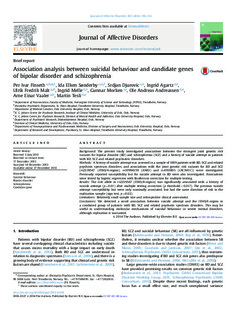| dc.contributor.author | Finseth, Per Ivar | |
| dc.contributor.author | Sønderby, Ida Elken | |
| dc.contributor.author | Djurovic, Srdjan | |
| dc.contributor.author | Agartz, Ingrid | |
| dc.contributor.author | Malt, Ulrik Fredrik | |
| dc.contributor.author | Melle, Ingrid | |
| dc.contributor.author | Morken, Gunnar | |
| dc.contributor.author | Andreassen, Ole Andreas | |
| dc.contributor.author | Vaaler, Arne Einar | |
| dc.contributor.author | Tesli, Martin Steen | |
| dc.date.accessioned | 2015-04-14T10:14:06Z | |
| dc.date.accessioned | 2015-05-26T14:10:55Z | |
| dc.date.available | 2015-04-14T10:14:06Z | |
| dc.date.available | 2015-05-26T14:10:55Z | |
| dc.date.issued | 2014 | |
| dc.identifier.citation | Journal of Affective Disorders 2014, 163:110-114 | nb_NO |
| dc.identifier.issn | 1573-2517 | |
| dc.identifier.uri | http://hdl.handle.net/11250/284064 | |
| dc.description.abstract | Background: The present study investigated associations between the strongest joint genetic risk
variants for bipolar disorder (BD) and schizophrenia (SCZ) and a history of suicide attempt in patients
with BD, SCZ and related psychiatric disorders.
Methods: A history of suicide attempt was assessed in a sample of 1009 patients with BD, SCZ and related
psychosis spectrum disorders, and associations with the joint genetic risk variants for BD and SCZ
(rs2239547 (ITIH3/4-region), rs10994359 (ANK3) and rs4765905 (CACNA1 C)) were investigated.
Previously reported susceptibility loci for suicide attempt in BD were also investigated. Associations
were tested by logistic regression with Bonferroni correction for multiple testing.
Results: The risk allele in rs2239547 (ITIH3/4-region) was significantly associated with a history of
suicide attempt (p ¼ 0.01) after multiple testing correction (p threshold o 0.017). The previous suicide
attempt susceptibility loci were only nominally associated, but had the same direction of risk in the
replication sample (sign test, p ¼ 0.02).
Limitations: Relatively small sample size and retrospective clinical assessment.
Conclusions: We detected a novel association between suicide attempt and the ITIH3/4-region in
a combined group of patients with BD, SCZ and related psychosis spectrum disorders. This may be
useful in understanding molecular mechanisms of suicidal behaviour in severe mental disorders,
although replication is warranted.
Keywords:
Suicidal behaviour;
Bipolar disorder;
Schizophrenia;
Candidate gene | nb_NO |
| dc.language.iso | eng | nb_NO |
| dc.publisher | Elsevier | nb_NO |
| dc.title | Association analysis between suicidal behaviour and candidate genes of bipolar disorder and schizophrenia | nb_NO |
| dc.type | Journal article | nb_NO |
| dc.type | Peer reviewed | en_GB |
| dc.date.updated | 2015-04-14T10:14:06Z | |
| dc.source.pagenumber | 110-114 | nb_NO |
| dc.source.volume | 163 | nb_NO |
| dc.source.journal | Journal of Affective Disorders | nb_NO |
| dc.identifier.doi | 10.1016/j.jad.2013.12.018 | |
| dc.identifier.cristin | 1104517 | |
| dc.description.localcode | (c) 2014 The Authors. Published by Elsevier B.V. Open access under CC BY-NC-ND license. | nb_NO |
